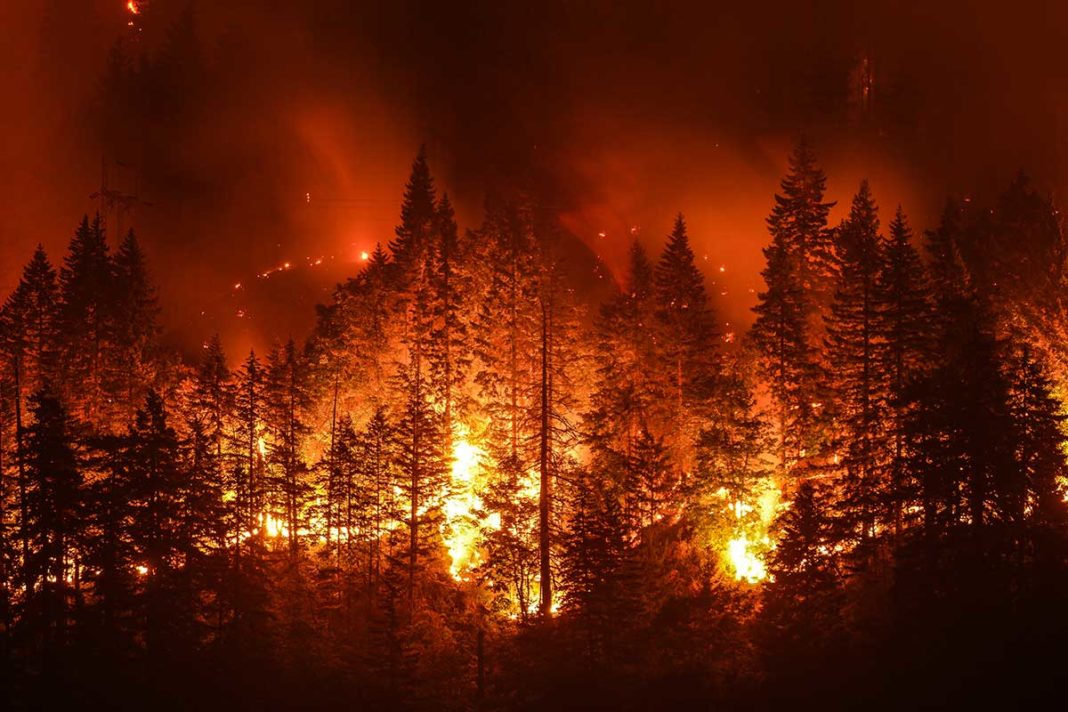MANITOULIN – Most of Northeastern Ontario is currently blanketed with smoke from active fires in Northwestern Ontario and eastern Manitoba, leading to ongoing air quality statements from Environment Canada. In recent weeks, smoke from wildfires burning across western Canada, the prairies and the western United States has been drifting eastward, following the jet stream across the continent to the Atlantic Ocean. This has led to hazy skies, bright red sunsets and even a reddish-orange moon. In some locations distant from the fires there is a scent of soot in the air.
The air quality index for Sudbury (the closest available reading) indicates a low to moderate risk over the next several days. Winds typically blow the smoke eastward at a fairly high altitude, between five and 10 kilometres, but that hasn’t been the case recently. NASA released satellite images of wildfire smoke clouds on July 23 that maps the concentration of black carbon particulates (soot) across North America. Soot is just one of several types of particles and gases found within wildfire smoke. NASA’s images indicated a significant amount of smoke lay below a two-kilometre altitude.
When the smoke remains at a higher altitude, the air may still appear hazy but ground level air quality measurements may show only low levels of pollutants, thus resulting in the low risk range. Conditions can change fairly quickly and may also be different in different parts of a community.
Environment Canada advises people to pay attention to conditions and take extra precautions to reduce your exposure to wildfire smoke, warning that it is “a constantly changing mixture of particles and gases which includes many chemicals that can be harmful to your health.”
Wildfire smoke can contain 50 times the amount of small particulate matter than the World Health Organization recommends for safe exposure. Difficulty breathing is the biggest and most obvious health impact of wildfire, followed by coughing and irritation, asthma flare-ups and other breathing problems. These are short-term risks that usually go away when the smoke goes away. Research is still underway on long-term impacts of short-term exposure to wildfire smoke.
Many experts agree that it’s climate change changing the nature and intensity of wildfires. In an earlier interview with The Expositor, Richard Carr of Natural Resources Canada, Canadian Fire Service said, “We’ve probably seen that over the past 10 or 20 years there have been more sustained fire seasons, probably lasting a bit longer. We’ve got bigger fires. We’ve got fires in areas that historically haven’t had many fires.”
Forest fires are heavily influenced by weather and the fire season is highly variable, a Ministry of Northern Development, Mines, Natural Resources and Forestry (MNRF) spokesperson explained. Fluctuations in climate are basically measured in decades so because of this variability, it’s difficult to connect any single fire season to the effects of climate change. Climate change, however, when combined with other factors is expected to increase the occurrences and associated overall risks of wildfires.
The current fires in Northwestern Ontario are a result of continuing unstable conditions across the province, the spokesperson said. Rainfall amounts to date have not been enough to have a significant impact on the current fires and resulting smoke drift, meaning we will continue to see smoke drift in the communities close to the fires. Smoke drift from these fires as well as from fires burning in western Canada and the United States will also remain detectable across much of the province.
To date over 3,000 members of several First Nations communities have been evacuated due to wildfires in northwestern Ontario. In a joint statement, Solicitor General Sylvia Jones and Minster Greg Rickford said, “As this year’s wildfire season continues, we continue to support communities in the north, and remain ready to provide all necessary additional support as required. We are working closely with the federal government, which is responsible for the health, safety, and wellbeing of First Nation communities on-reserve. The province also continues to collaborate closely with affected First Nation communities, participating municipalities, the federal government, and the NGO sector to ensure that all necessary resources are deployed.”
There are 151 active fires in Ontario of which 138 are in the Northwest and 13 in the Northeast. As of July 25, 2021 there have been 902 fires in the province compared to 457 for all of 2020 and almost double the 10 year average of 520. So far this year 520,134 hectares have been affected by wildfires in Ontario. That’s a significant increase over the 6,416 hectares burned in 2020 and more than three times the 10-year average of 153,513 hectares.





